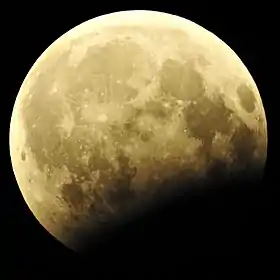September 2015 lunar eclipse
A total lunar eclipse took place between September 27 and 28, 2015. It was seen on Sunday evening, September 27, in the Americas; while in Europe, Africa, and the Middle East, it was seen in the early hours of Monday morning, September 28. It was the latter of two total lunar eclipses in 2015, and the final in a tetrad (four total lunar eclipses in series). Other eclipses in the tetrad are those of April 15, 2014, October 8, 2014, and April 4, 2015.
| Total eclipse | |||||||||||||||||
 From Murrieta, California, 2:52 UTC | |||||||||||||||||
| Date | 28 September 2015 | ||||||||||||||||
|---|---|---|---|---|---|---|---|---|---|---|---|---|---|---|---|---|---|
| Gamma | -0.3296 | ||||||||||||||||
| Magnitude | 1.2764 | ||||||||||||||||
| Saros cycle | 137 (27 of 80) | ||||||||||||||||
| Totality | 71 minutes, 55 seconds | ||||||||||||||||
| Partiality | 199 minutes, 54 seconds | ||||||||||||||||
| Penumbral | 310 minutes, 47 seconds | ||||||||||||||||
| |||||||||||||||||
The Moon appeared larger than normal, because the Moon was just 1 hour past its closest approach to Earth in 2015 at mid-eclipse, sometimes called a supermoon. The Moon's apparent diameter was larger than 34' viewed straight overhead, just off the coast of northeast Brazil.[1][2]
The total lunar eclipse was darker than expected, possibly due to ash left behind from eruptions of the Calbuco volcano in April 2015.[3]
Background
A lunar eclipse occurs when the Moon passes within Earth's umbra (shadow). As the eclipse begins, Earth's shadow first darkens the Moon slightly. Then, the shadow begins to "cover" part of the Moon, turning it a dark red-brown color (typically – the color can vary based on atmospheric conditions). The Moon appears to be reddish because of Rayleigh scattering (the same effect that causes sunsets to appear reddish) and the refraction of that light by Earth's atmosphere into its umbra.[4]
The following simulation shows the approximate appearance of the Moon passing through Earth's shadow. The Moon's brightness is exaggerated within the umbral shadow. The northern portion of the Moon was closest to the center of the shadow, making it darkest, and most red in appearance.

Visibility
The eclipse was visible over Europe, the Middle East, Africa, and America.
 View of Earth from Moon at greatest eclipse |
 Simulated appearance of Earth and atmospheric ring of sunlight |
 | |
|---|---|
Timing
| Time Zone adjustments from UTC |
-7h | -6h | -5h | -4h | -3h | -2h | -1h | 0h | +1h | +2h | +3h | |
|---|---|---|---|---|---|---|---|---|---|---|---|---|
| PDT MST |
MDT | CDT PET |
EDT BOT |
ADT AMST ART |
GMT WET |
WEST CET BST |
CEST EET MSK−1 |
EEST FET MSK | ||||
| Event | Evening September 27 | Morning September 28 | ||||||||||
| P1 | Penumbral begins* | N/A† | N/A† | 7:12 pm | 8:12 pm | 9:12 pm | 10:12 pm | 11:12 pm | 12:12 am | 1:12 am | 2:12 am | 3:12 am |
| U1 | Partial begins | N/A† | 7:07 pm | 8:07 pm | 9:07 pm | 10:07 pm | 11:07 pm | 12:07 am | 1:07 am | 2:07 am | 3:07 am | 4:07 am |
| U2 | Total begins | 7:11 pm | 8:11 pm | 9:11 pm | 10:11 pm | 11:11 pm | 12:11 am | 1:11 am | 2:11 am | 3:11 am | 4:11 am | 5:11 am |
| Mid-eclipse | 7:47 pm | 8:47 pm | 9:47 pm | 10:47 pm | 11:47 pm | 12:47 am | 1:47 am | 2:47 am | 3:47 am | 4:47 am | 5:47 am | |
| U3 | Total ends | 8:23 pm | 9:23 pm | 10:23 pm | 11:23 pm | 12:23 am | 1:23 am | 2:23 am | 3:23 am | 4:23 am | 5:23 am | 6:23 am |
| U4 | Partial ends | 9:27 pm | 10:27 pm | 11:27 pm | 12:27 am | 1:27 am | 2:27 am | 3:27 am | 4:27 am | 5:27 am | 6:27 am | Set |
| P4 | Penumbral ends | 10:22 pm | 11:22 pm | 12:22 am | 1:22 am | 2:22 am | 3:22 am | 4:22 am | 5:22 am | 6:22 am | Set | Set |
† The Moon was not visible during this part of the eclipse in this time zone.
* The penumbral phase of the eclipse changes the appearance of the Moon only slightly and is generally not noticeable.[5]

The timing of total lunar eclipses are determined by its contacts:[6]
- P1 (First contact): Beginning of the penumbral eclipse. Earth's penumbra touches the Moon's outer limb.
- U1 (Second contact): Beginning of the partial eclipse. Earth's umbra touches the Moon's outer limb.
- U2 (Third contact): Beginning of the total eclipse. The Moon's surface is entirely within Earth's umbra.
- Greatest eclipse: The peak stage of the total eclipse. The Moon is at its closest to the center of Earth's umbra.
- U3 (Fourth contact): End of the total eclipse. The Moon's outer limb exits Earth's umbra.
- U4 (Fifth contact): End of the partial eclipse. Earth's umbra leaves the Moon's surface.
- P4 (Sixth contact): End of the penumbral eclipse. Earth's penumbra no longer makes contact with the Moon.
Gallery
 The stages of the Lunar eclipse from Staffordshire, UK
The stages of the Lunar eclipse from Staffordshire, UK Time-lapse images from Oslo, Norway
Time-lapse images from Oslo, Norway Time-lapse images from Bregenz, Austria
Time-lapse images from Bregenz, Austria Warsaw, Poland, 2:01 - 2:16 UTC
Warsaw, Poland, 2:01 - 2:16 UTC Denver, Colorado, 2:15 UTC
Denver, Colorado, 2:15 UTC Fray Bentos, Uruguay 2:28 UTC
Fray Bentos, Uruguay 2:28 UTC.jpg.webp) Tampa, Florida, 2:30 UTC
Tampa, Florida, 2:30 UTC.jpg.webp) New York City, New York, 2:36 UTC
New York City, New York, 2:36 UTC Wrocław, Poland, 2:36 UTC
Wrocław, Poland, 2:36 UTC.jpg.webp) Zürich, Switzerland, 2:36 UTC
Zürich, Switzerland, 2:36 UTC Coralville, Iowa, 2:52 UTC
Coralville, Iowa, 2:52 UTC Munich, Germany, 2:55 UTC
Munich, Germany, 2:55 UTC Sitia, Greece, 3:01 UTC
Sitia, Greece, 3:01 UTC Berlin, Germany, 3:05 UTC
Berlin, Germany, 3:05 UTC.jpg.webp) Mill Valley, California, 3:07 UTC
Mill Valley, California, 3:07 UTC Munich, Germany, 3:23 UTC
Munich, Germany, 3:23 UTC Boston, Massachusetts, 3:24 UTC
Boston, Massachusetts, 3:24 UTC Germany, 3:37 UTC
Germany, 3:37 UTC.jpg.webp) Cosne-Cours-sur-Loire, France, 4:02 UTC
Cosne-Cours-sur-Loire, France, 4:02 UTC California, 4:07 UTC
California, 4:07 UTC
Supermoon
This eclipsed moon appeared 12.9% larger in diameter than the April 2015 lunar eclipse, measured as 29.66' and 33.47' in diameter from earth's center, as compared in these simulated images.
A supermoon is the coincidence of a full moon or a new moon with the closest approach the Moon makes to the Earth on its elliptical orbit, resulting in the largest apparent size of the lunar disk as seen from Earth. This was the last supermoon lunar eclipse until 31 January 2018.
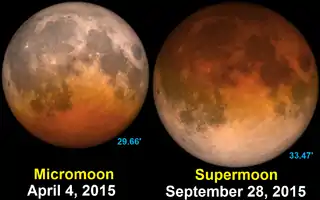
Related eclipses
Eclipses of 2015
- A total solar eclipse on March 20.
- A total lunar eclipse on April 4.
- A partial solar eclipse on September 13.
- A total lunar eclipse on September 28.
The eclipse was one of four lunar eclipses in a short-lived series at the descending node of the Moon's orbit.
The lunar year series repeats after 12 lunations, or 354 days (shifting back about 10 days in sequential years). Because of the date shift, Earth's shadow will be about 11 degrees west in sequential events.
| Lunar eclipse series sets from 2013–2016 | ||||||||
|---|---|---|---|---|---|---|---|---|
| Ascending node | Descending node | |||||||
| Saros | Viewing date |
Type | Gamma | Saros | Viewing date |
Type | Gamma | |
112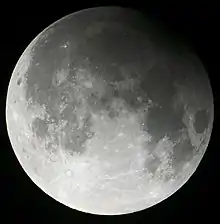 |
2013 Apr 25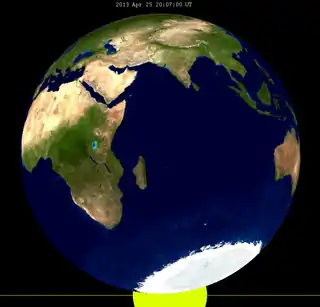 |
Partial |
-1.0121 | 117_(cropped).jpg.webp) |
2013 Oct 18 |
Penumbral |
1.1508 | |
122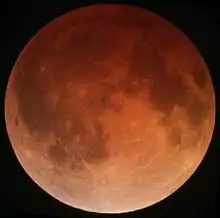 |
2014 Apr 15 |
Total |
-0.3017 | 127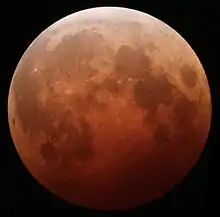 |
2014 Oct 08 |
Total |
0.3827 | |
132 |
2015 Apr 04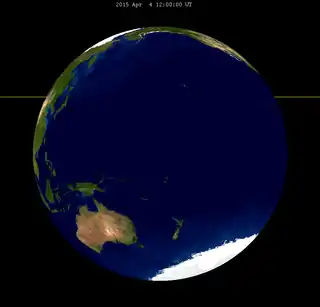 |
Total |
0.4460 | 137 |
2015 Sep 28 |
Total |
-0.3296 | |
| 142 | 2016 Mar 23 |
Penumbral |
1.1592 | 147.jpg.webp) |
2016 Sep 16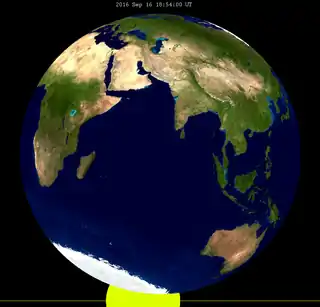 |
Penumbral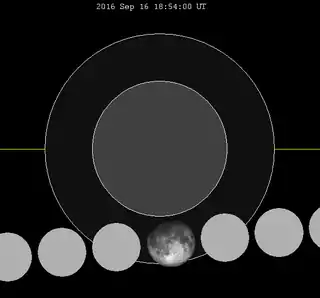 |
-1.0549 | |
| Last set | 2013 May 25 | Last set | 2012 Nov 28 | |||||
| Next set | 2017 Feb 11 | Next set | 2016 Aug 18 | |||||
Half-Saros cycle
A lunar eclipse will be preceded and followed by solar eclipses by 9 years and 5.5 days (a half saros).[7] This lunar eclipse is related to two annular solar eclipses of solar saros 144.
| September 22, 2006 | October 2, 2024 |
|---|---|
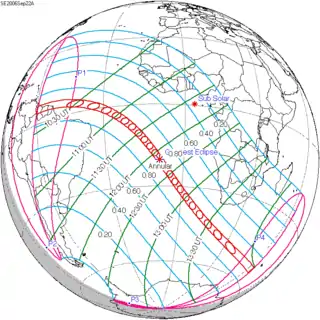 |
 |
See also
- List of lunar eclipses and List of 21st-century lunar eclipses
References
- Sky and Telescope
- Here’s the Scoop on Sunday’s Supermoon Eclipse, Bob King
- "Why Was September's Lunar Eclipse So Dark? - Universe Today". Universe Today. 5 October 2015. Retrieved 8 August 2017.
- Fred Espenak & Jean Meeus. "Visual Appearance of Lunar Eclipses". NASA. Retrieved 13 April 2014.
- Espenak, Fred. "Lunar Eclipses for Beginners". MrEclipse. Retrieved 7 April 2014.
- Clarke, Kevin. "On the nature of eclipses". Inconstant Moon. Cyclopedia Selenica. Retrieved 19 December 2010.
- Mathematical Astronomy Morsels, Jean Meeus, p.110, Chapter 18, The half-saros
External links
| Wikimedia Commons has media related to Lunar eclipse of 2015 September 28. |
- 2015 Sep 28 chart: Eclipse Predictions by Fred Espenak, NASA/GSFC
- Hermit eclipse: 2015-09-28
